The next-gen MacBook Pro with Retina Display Review
by Anand Lal Shimpi on June 23, 2012 4:14 AM EST- Posted in
- Mac
- Apple
- MacBook Pro
- Laptops
- Notebooks
General Performance
The Retina MacBook Pro can complete a full boot from power off to usable desktop in just over 17 seconds. It’s a hair faster than last year’s MacBook Airs, a bit quicker than the old SSD equipped MacBook Pro, and night and day compared to any Mac with a hard drive. Four years ago I said that Solid State Drives were the single biggest upgrade you could do for your computer, and it couldn’t be any more true today.
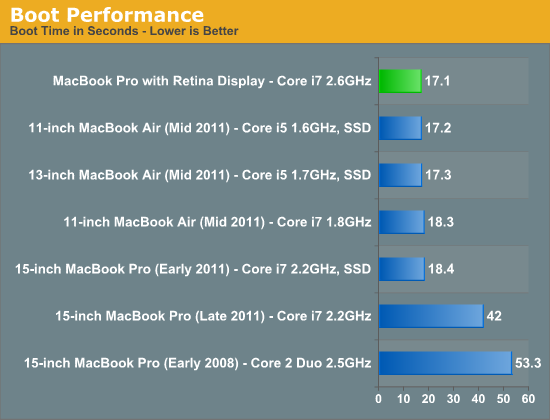
The Retina MBP behaves more like the 3rd gen MacBook Air in how it goes to sleep and wakes up. Both happen virtually instantaneously, and if your battery dies while asleep you don’t get the greyed out screen with progress bar as your environment is restored from disk - it just appears, taking a couple of seconds for the clock to update and everything else to come to life. It’s a small but subtle change that tells you the rMBP is in a distinctly different class. Apple’s tight control over firmware and storage interface help it deliver up to 30 days of standby power, a number I’ll really need to verify one of these days.
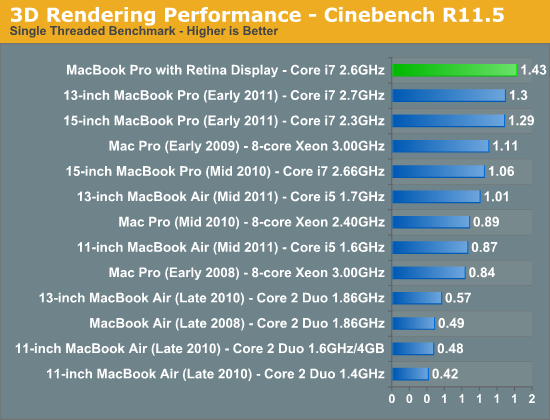
Raw CPU performance is up handsomely over the 2011 MacBook Pros, at least in their standard configurations. The 2.6GHz chip in the $2799 rMBP can turbo up to 3.6GHz when only a single core is active, delivering a 13% increase in performance over the previous generation 2.2GHz part. Compared to the upgraded 2.4GHz Sandy Bridge Core i7 from last year (not pictured) however, I would expect a sub-10% advantage.
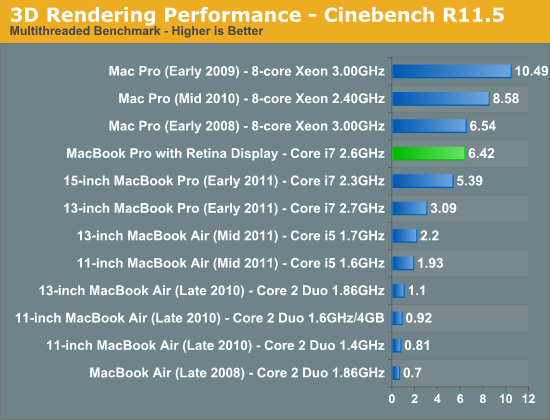
With all four cores active the 2.6GHz chip can run at up to 3.4GHz, which it regularly hits as long as the Kepler GPU stays asleep. The 2.2GHz Sandy Bridge based 2011s we’re comparing to on the other hand can only turbo up to 2.8GHz. Here the advantage is a more tangible 19%, although once again if you are comparing to one of the 2.4GHz parts from last year I would expect notably smaller gains (mid to high single digit percentages). The improved thermal characteristics may allow mobile Ivy Bridge to operate in turbo modes for longer than Sandy Bridge, however I don’t have any data to actually support that claim. That doesn’t mean it can’t happen, it’s just complex to test and model.
While the Cinebench tests are largely CPU bound, many of the following tests are largely influenced by the SSD in the Retina MacBook Pro. Here we see some huge gains, especially compared to older HDD based Macs.
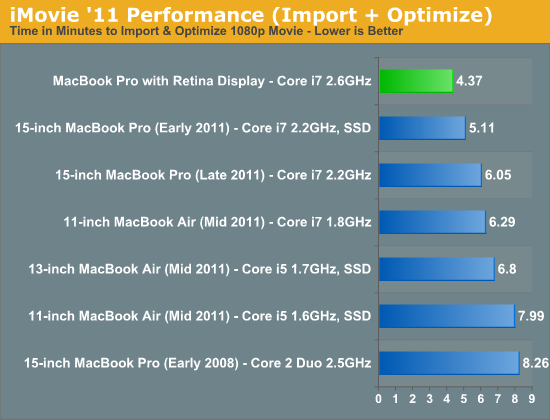
iMovie import time is heavily influenced by disk as well as CPU performance. As a result there are big improvements over both the HDD and SSD equipped 2011 MBPs.

Export time is more heavily CPU bound and here the advantage over the previous generation notebooks is pretty much nonexistent.
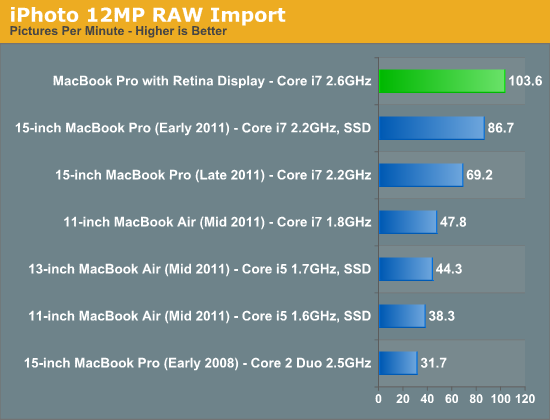
Our iPhoto import test stresses both disk and CPU, giving the rMBP a tangible advantage compared to the SSD equipped 2011 MBP. None of the dual-core or HDD based Macs stand a chance here.

Our Lightroom test continues the storage/CPU dependencies as only the SSD equipped 2011 MBP is able to come close to the rMBP’s performance. There’s not much of a performance advantage here when you compare similarly equipped systems though. Ivy Bridge may have been a good upgrade from a power standpoint, but it doesn’t tell a significantly different performance story in all cases.
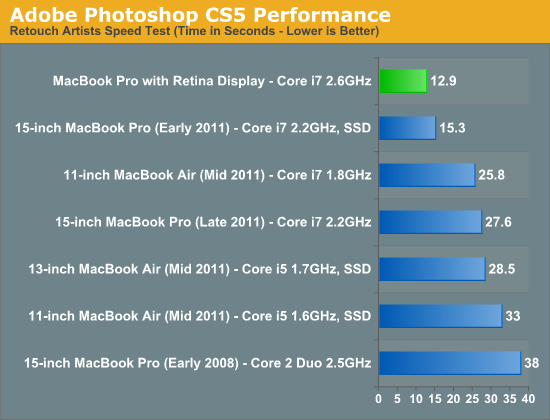
The rMBP cranks through our Photoshop workload fairly quickly. The performance advantages here are likely due to increased memory, a much faster SSD and obvious CPU speed improvements as well.
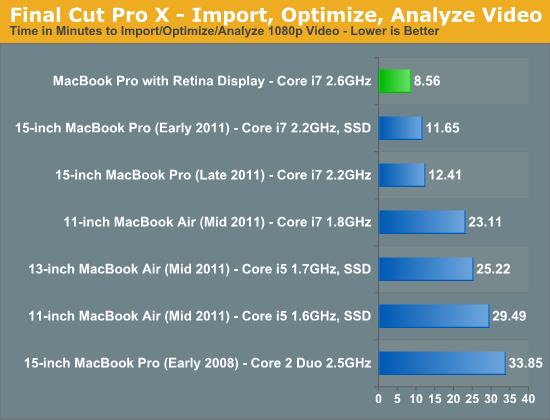
The same holds true for the advantages in our Final Cut Pro X test. As a default configuration the $2799 MacBook Pro with Retina Display is easily the fastest notebook Apple has ever shipped. It’s only if you had an upgraded 2011 model (perhaps with an aftermarket SSD?) that you’ll be unimpressed by the move.
I can’t stress enough how much the new SSD improves the overall experience. It’s just so much faster than what Apple used to ship.










471 Comments
View All Comments
Super56K - Saturday, June 23, 2012 - link
Maybe talking paper specs on the software side it's 'the same' but really that's not even close. Dpi scaling is flaky in Windows anyways.And it's really not the same. It's rendered at double the resolution on a screen that actually has 4x's the pixels at the native 1440x900 res. Nobody else does that. Hell, it's rare to even find a 16:10 Windows laptop.
I don't own a MacBook anything, but some of you sound ridiculous in here going on about Sony laptops with 1080p screens
Spunjji - Tuesday, June 26, 2012 - link
What if I, the user, don't want my laptop rendering the display at a pointlessly high resolution just to scale it back down again? I understand the theory but the execution is utterly ridiculous.UpSpin - Saturday, June 23, 2012 - link
You're right, it wouldn't sell, because the issue is that Windows DPI scaling doesn't work so well. It also doesn't work perfectly in Mac OS (Chrome best example, they had to update it). And so will many older programs, which don't receive further updates, like Adobe Creative Suite <6 don't scale right (assumption)That's one reason that Apple released only one MacBook with a retina display, because the software isn't ready for DPI scaling yet. Apple was brave enough to do the step and force programers to integrate scaling in high res images in their programs because future MacBooks will have retina displays only.
No PC manuafcturer could have done such a step, they would have been blocked by the lack of proper scaling of Windows, rendering a high res display useless because of display errors. So Microsoft should have made Windows 7 resolution independent (just as all mobile OS are, which rely on DPI instead of absolute pixels), then PC manufacturers could have included high res displays which the customer could have used.
EnzoFX - Saturday, June 23, 2012 - link
MS Should have with Win7? Hardly. That was too long ago and there were no retina screens yet. Even 1080p screens were scarce. Remember that 99% were getting 1366x768 in their laptops.You're right in that Apple can sort of force developers to update apps for support. I do give them credit for usually implementing a solid stopgap. Their scaling for older apps is usually good enough without it being a bad experience. Forcing them to update is a good thing though, having that ecosystem of active developers is good. It's further easier on them to target simple hardware configurations. The benefits of vertical integration at its best. Now for these retina displays to trickle down to all their displays =P.
ananduser - Saturday, June 23, 2012 - link
Win7 scales perfectly well for a screen this res. Such an absurd panel jump however is meant as bragging rights. It also serves as differentiation. Instead of going "post PC" like W8 transformer devices at Computex, it adds a huge panel. There's nothing special about the hardware that hasn't been done before, except the impressive panel.Ohhmaagawd - Saturday, June 23, 2012 - link
Exactly what would constitute "special"?dagamer34 - Sunday, June 24, 2012 - link
Mobile operating systems aren't resolution independent. The iPhone supports 2 resolutions, Windows Phone currently supports 1 resolution, but will support 3 in WP8, and Android supports a variety of resolutions, but is NOT resolution independent.garcondebanane - Saturday, June 23, 2012 - link
Frankly, yes I think so. See "the software side of retina" and "Achieving retina".I don't think any other PC manufacturer can realistically be expected to do it this seamlessly.
UberApfel - Saturday, June 23, 2012 - link
Apple didn't think of the idea. The screens are simply now available and Apple has the resources and reason to push it to market first. Apple also has their own operating system and software engineers to prepare for such.Anyone familiar with the market knows that Microsoft is a big kid nurtured by monopoly and ripping off corporations. The 'big game-changing release & failure' every few years just doesn't allow manufacturers to be first-adopters. Only OSX stays up-to-date, and only Apple may use OSX thanks to either IP or special-order hardware.
If Asus, Acer, or Toshiba were to shell out the cash to get a portion of the first batch and mass-produce some laptops w/ "retina display"; they'd just have a deficit. Apple is a designer; not a innovator. Anyone who makes that mistake is a fool.
MrSpadge - Monday, June 25, 2012 - link
It's not only about thinking about it, it's about building it and reaching out to make people buy it. It's hard to do this without the "Apple hype", no matter how good and innovative the product may be.